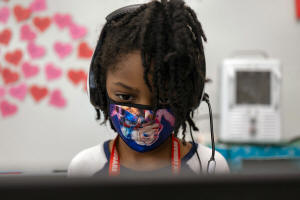U.S. CDC updates school guidance to emphasize in-person learning
 Send a link to a friend
Send a link to a friend
 [July 10, 2021]
By Deena Beasley [July 10, 2021]
By Deena Beasley
(Reuters) -The U.S. Centers for Disease
Control and Prevention (CDC) on Friday updated its guidance for U.S.
schools reopening in the fall, recommending masking indoors for everyone
who is not fully vaccinated against COVID-19 and three feet of distance
within classrooms.
The agency said school administrators can require indoor mask use even
for students and educators who are vaccinated, depending on the needs of
the community. Reasons would include schools with children under age 12,
who are not currently authorized to receive COVID-19 vaccines, or high
rates of COVID-19 transmission in the region.
"The guidance does reflect the fact that vaccination makes it easier to
conduct school in person, which should be the default," said Dr. Amesh
Adalja, an infectious disease specialist at Johns Hopkins University.
But it involves "a lot of hedging and risk calculation," he added.
California said it would continue to require all students and educators
to wear masks during school, citing the fact that many of its school
facilities can’t accommodate physical distancing.

“Masking is a simple and effective intervention," California Health &
Human Services Agency Secretary Dr. Mark Ghaly said in a statement. He
also said the requirement would ensure that all kids are treated the
same.
The National Education Association, the largest U.S. teachers union,
said the updated CDC guidance offers a roadmap for students to return to
school.
"Everyone who is eligible to be vaccinated should get their COVID-19
vaccination... Schools should be consistently and rigorously employing
all the recommended mitigation strategies," NEA President Becky Pringle
said in a statement.
Schools throughout the United States began to close in March of 2020 as
the COVID-19 pandemic took hold and many students were shifted to online
learning at home. Critics had accused teacher unions of slowing
reopenings by demanding virus mitigation practices, such as universal
masking, fewer kids in classrooms and social distancing. [L1N2K12OT]
MORE DEBATE
The updated guidance is likely to set off more debate about what is
appropriate. Some regions have stricter guidelines than the others.
"Most of the school debate has not been adherent to science - it has
really been linked to politics and teacher unions," Adalja said.
The American Federation of Teachers, the second-largest U.S. teachers'
union, said the new CDC guidance makes sense and will help students
return to the classroom.
[to top of second column]
|

A student sits at her computer at Kratzer Elementary School in
Allentown, Pennsylvania, U.S., April 13, 2021. Picture taken April
13, 2021. REUTERS/Hannah Beier

“The guidance confirms two truths: that students
learn better in the classroom, and that vaccines remain our best bet
to stop the spread of this virus," AFT President Randi Weingarten
said in a statement.
The CDC said schools should rely on local health data when deciding
to relax or tighten prevention strategies, including mask wearing
and physical distancing.
"Because of the importance of in-person learning, schools where not
everyone is fully vaccinated should implement physical distancing to
the extent possible within their structures, but should not exclude
students from in-person learning to keep a minimum distance
requirement," the new guidance said.
The agency said its recommendations are appropriate even with the
spread of the highly contagious Delta variant of the coronavirus.
"What we have seen is that students are capable of wearing masks ...
Should there be evidence of variants spreading, masks reduce the
risk," said Dr. Nathaniel Beers, co-author of the American Academy
of Pediatrics’ (AAP) school opening guidelines.
He said updated AAP guidance will be announced within the next
couple of weeks.
A study by the CDC released on Friday showed that half of
unvaccinated adolescents and parents of unvaccinated adolescents
reported being uncertain about getting a COVID-19 vaccine, or did
not intend to get one at all.

Nationwide, according to the CDC statistics on Friday, around 55% of
the overall population and 67% of adults have received at least one
COVID-19 vaccination dose.
(Reporting by Deena Beasley in Los Angeles and Mrinalika Roy in
Bengaluru; Editing by Dan Grebler and Aurora Ellis)
[© 2021 Thomson Reuters. All rights
reserved.] Copyright 2021 Reuters. All rights reserved. This material may not be published,
broadcast, rewritten or redistributed.
Thompson Reuters is solely responsible for this content. |